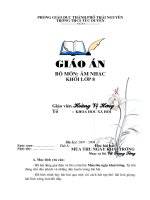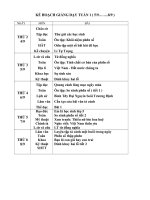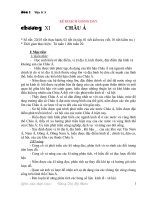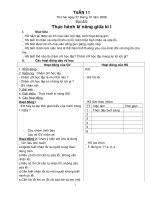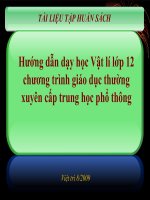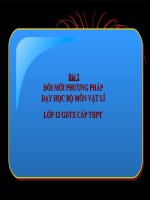BÀI GIẢNG LỚP Y SỸ pe abdominalexam
Bạn đang xem bản rút gọn của tài liệu. Xem và tải ngay bản đầy đủ của tài liệu tại đây (1.54 MB, 20 trang )
Abdominal Exam
Charlie Goldberg, MD
Professor of Medicine, UCSD SOM
Abdominal Exam
• 4 Elements: Observation, Auscultation,
Percussion, Palpation
• Pelvic, male genital & male/female rectal
exams all critical parts of Abdomen exam
covered later in the year
GI Review of Systems
• />
Surface Anatomy
Epigastric Area
Umbillicus
Supra-Pubic Area
Hammer & Nails icon indicates A Slide
Describing Skills You Should Perform In Lab
Observation & Draping
• Exposure Drape
for success –
expose what you
need to see!
• Use sheet to cover
lower 1/2
• Good lighting, warm
room, table flat,
hands at side, head
resting on table
• +/- Feet flat on table
Observation (cont)
• Make note of :
–
–
–
–
–
general shape
contours
symmetry
color
scars
• ? easiest to make
observations from
foot of bed.
• Examine from right
side
Examples of Abnormal Findings On
Observation
Obese
Ascites (fluid), Yellow
Umbilical Hernia (Right with Valsalva)
Enlarged gall
bladder
Auscultation
• Normal intestinal propulsion of
food (peristalsis) generates
noise (Borborygmi)
• Listen (diaphragm of
stethoscope) x 15-20 seconds in
4 quadrants
• Pay attention to: presence,
quantity (normal ~ 2-5 seconds),
& quality of sounds
Auscultation (cont)
•
•
•
•
Clinical utility:
– Intestinal Obstruction:
Increased frequency early
(“rushes’) declines in
quantity, increase pitch
(“tinkles”) stop
– After handled (surgery) no
function or noise (ileus)
w/normal recovery, noise
returns
– Infection of mucosa
(gastroenteritis) increased
frequency
No findings pathognomonic
Auscultation not helpful in
otherwise normal exam
Clinical context most important
Auscultation (cont)
• Bruits - sounds of
turbulent arterial flow
atherosclerosis
• Listen over:
– Renal arteries
(several cm above
umbilicus, either side
rectus)
– Iliac arteries (below
umbilicus)
Percussion
• Same principle as Lung
• Tapping over solid or liquid filled structure
dull tone; air filled tympanitic (resonant)
• Percussion what’s beneath
skin & bones – e.g: liver dull; air filled
stomach tympanitic
• Abdomen not designed w/1st yr med students in
mind!
- Important solid structures protected: liver &
spleen by ribs; pancreas & kidneys deep in
retro-peritoneum; bladder & uterus in pelvis
- Central abdomen filled w/intestines: freely
moving promotes peristalsis, tolerates direct
trauma
Percussion Technique
• Stand on R
• Middle finger of nonpercussing hand firmly
against abdomen
• Using floppy wrist
action, hammer middle
finger of other hand
down, aiming for last joint
• Percuss all 4 quadrants
– normal =‘s mix of dull
and tympanitic
Percussion Technique (cont)
• Liver span (6-12 cm) –
Start in chest, below
nipple (mid-clavicular
line) & move down –
tone changes from
resonant (lung) to dull
(liver) to resonant
(intestines)
• Spleen – small, located
in hollow of ribs –
percussion over last
intercostal space,
anterior axillary line
should normally be
resonant – dullness
suggests splenomegaly
• Stomach – tympanitic
Resonance
to percussion
If normal (i.e.
spleen not
enlarged)
Stomach
Percussion – Shifting Dullness
• Detect large
amounts of
pathological fluid
(ascites)
• Intestines will
float to surface
• Percussion can
detect air-fluid
interface
• Change in
position shifts
point of interface
“Intestines”
“Ascites”
Palpation
• Most important
structures aren’t
palpable
• Warm your hands
• Generally right hand
used (left placed on top
or @ your side)
• Palpate using pads &
edges of middle 3 fingers
• Gentle pressure, no
sudden movements
• Think about what “lives”
in area you’re examining
Palpation Technique
• First explore superficial
aspect each quadrant
(start R lower R
upperL upperL lower)
• Deeper palpation
Liver
– Start R lower, moving up
towards R ribs
– Move hands a few cm up
w/each palpation
– Push down (posterior) &
then towards head
– As approach ribs, palpate
while patient inspires
deeply (diaphragm brings
liver down towards hand)
– Might feel liver edge in
normals (usually not)
Palpation Technique (cont)
• Deeper Palpation (cont)
Spleen
– Palpate towards left upper
quadrant from midline &
below - use L hand to “pull”
spleen towards you
Aorta
– Above umbillicus, left of
midline
– Push down (deep)
w/palpating hand
Remainder of abdomen
– Uterus, bladder, other
(rarely palpable)
• Evaluate painful areas
last!
Palpation/Percussion Of
The Kidneys
• Kidneys are
retroperitoneal structures,
deep & protected by the ribs
rarely palpable
• If markedly enlarged, may
appreciate in lateral aspects
abdomen (rare)
• Assess for tenderness via
posterior approach, tapping
on back at Costo-Vertebral
Angle – if kidney infected
(pyelonephritis), patient will
have Tenderness (CVAT)
Exposed Deep
Retroperitoneum
Area of Costo (rib)Vetebral Angle(s)
Kidneys
Put Findings Together Paint The
Best Picture
Abdominal exam techniques compliment each
other!
• Ascites
• Enlarged liver
(hepatomegaly)
– Observe distention,
bulging flanks
– Palpation no
evidence of mass
– Percussion shifting
dullness
– Percussion indicates
extension of liver
below diaphragm
– Palpation confirms
location of lower edge
(also detects contour,
texture)
Summary Of Skills
□ Wash Hands
□ Observe abdomen (shape, contours, scars,
color, etc)
□ Auscultate abdomen (bowel sounds, bruits)
□ Percuss abdomen (general; then liver & spleen)
□ Palpate 4 quadrants abdomen (superficial then
deep)
□ Assess for kidney area pain (CVAT)
Time Target: < 10 Minutes
